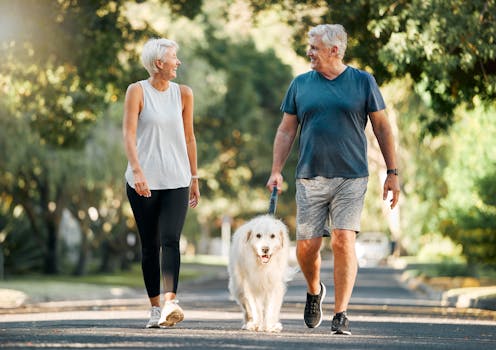How 22 minutes of exercise a day could reduce the health risks from sitting too long
- Written by Matthew Ahmadi, Postdoctoral Research Fellow, Faculty of Medicine and Health, University of Sydney

People in developed countries spend an average of nine to ten hours[1] a day sitting. Whether it’s spending time in front of a computer, stuck in traffic, or unwinding in front of the TV, our lives have become increasingly sedentary.
This is concerning because prolonged time spent sitting is linked to a number of health issues[2] including obesity, heart disease, and certain types of cancers. These health issues can contribute to earlier death.
But a new study[3] suggests that for people over 50, getting just 22 minutes of exercise a day can lower the increased risk of premature death from a highly sedentary lifestyle.
Read more: Good news for 'weekend warriors': people who do much of their exercise on a couple of days still get heart benefits[4]
What the researchers did
The team combined data from two studies from Norway, one from Sweden and one from the United States. The studies included about 12,000 people aged 50 or older who wore wearable devices to track how active and sedentary they were during their daily routines.
Participants were followed up for at least two years (the median was 5.2 years) during the study period, which spanned 2003-2020.
Analyses took several lifestyle and health factors into account, such as education, alcohol intake, smoking status, and previous history of heart disease, cancer and diabetes. All this data was linked to national death registries.
A 22 minute threshold
A total of 805 participants died during follow up. The researchers found people who were sedentary for more than 12 hours a day had the highest risk of death (a 38% higher risk than people who were sedentary for eight hours).
However, this was only observed in those who did less than 22 minutes of moderate to vigorous physical activity daily. So for people who did more than 22 minutes of exercise, there was no longer a significantly heightened risk – that is, the risk became generally similar to those who were sedentary for eight hours.
Higher daily duration of physical activity was consistently associated with lower risk of death, regardless of total sedentary time. For example, the team reported an additional ten minutes of moderate to vigorous physical activity each day could lower mortality risk by up to 15% for people who were sedentary less than 10.5 hours a day. For those considered highly sedentary (10.5 hours a day or more), an additional ten minutes lowered mortality risk by up to 35%.
The study had some limitations
The team couldn’t assess how changes in physical activity or sedentary time over several months or years may affect risk of death. And the study included only participants aged 50 and above, making results less applicable to younger age groups.
Further, cultural and lifestyle differences between countries may have influenced how data between studies was measured and analysed.
Ultimately, because this study was observational, we can’t draw conclusions on cause and effect with certainty. But the results of this research align with a growing body of evidence exploring the relationship between physical activity, sedentary time, and death.
It’s positive news
Research has previously suggested physical activity may offset[6] health risks associated with high sedentary time[7].
The good news is, even short bouts of exercise can have these positive effects. In this study, the 22 minutes wasn’t necessarily done all at once. It was a total of the physical activity someone did in a day, and would have included incidental exercise (activity that’s part of a daily routine, such as climbing the stairs).
Several studies using wearable devices have found short bursts of high-intensity everyday activities such as stair climbing or energetic outdoor home maintenance activities such as mowing the lawn or cleaning the windows can lower mortality[8], heart disease[9] and cancer[10] risk.
A recent study using wearable devices found moderate to vigorous bouts of activity lasting three to five minutes[12] provide similar benefits to bouts longer than ten minutes when it comes to stroke and heart attack risk.
Several other studies have found being active just on the weekend[13] provides similar health benefits as being active throughout the week[14].
Research has also shown the benefits of physical activity[15] and reducing sedentary time[16] extend to cognitive health.
Read more: Treadmill, exercise bike, rowing machine: what's the best option for cardio at home?[17]
Routines such as desk jobs can foster a sedentary lifestyle that may be difficult to shift. But mixing short bursts of activity into our day can make a significant difference towards improving our health and longevity.
Whether it’s a brisk walk during lunch, taking the stairs, or even a short at-home workout, this study is yet another to suggest that every minute counts.
References
- ^ nine to ten hours (doi.org)
- ^ linked to a number of health issues (bjsm.bmj.com)
- ^ new study (doi.org)
- ^ Good news for 'weekend warriors': people who do much of their exercise on a couple of days still get heart benefits (theconversation.com)
- ^ LStockStudio/Shutterstock (www.shutterstock.com)
- ^ physical activity may offset (bjsm.bmj.com)
- ^ high sedentary time (www.jacc.org)
- ^ mortality (www.nature.com)
- ^ heart disease (academic.oup.com)
- ^ cancer (jamanetwork.com)
- ^ GaudiLab/Shitterstock (www.shutterstock.com)
- ^ lasting three to five minutes (www.thelancet.com)
- ^ being active just on the weekend (jamanetwork.com)
- ^ being active throughout the week (jamanetwork.com)
- ^ physical activity (jamanetwork.com)
- ^ reducing sedentary time (jamanetwork.com)
- ^ Treadmill, exercise bike, rowing machine: what's the best option for cardio at home? (theconversation.com)

















